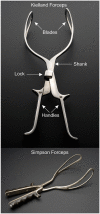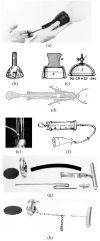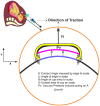An engineering perspective of vacuum assisted delivery devices in obstetrics: A review
- PMID: 32928047
- PMCID: PMC7780266
- DOI: 10.1177/0954411920956467
An engineering perspective of vacuum assisted delivery devices in obstetrics: A review
Abstract
Complications during childbirth result in the need for clinicians to use 'assisted delivery' in over 12% of cases (UK). After more than 50 years in clinical practice, vacuum assisted delivery (VAD) devices remain a mainstay in physically assisting child delivery; sometimes preferred over forceps due to their ease of use and reduced maternal morbidity. Despite their popularity and enduring track-record, VAD devices have shown little evidence of innovation or design change since their inception. In addition, evidence on the safety and functionality of VAD devices remains limited but does present opportunities for improvements to reduce adverse clinical outcomes. Consequently in this review we examine the literature and patent landscape surrounding VAD biomechanics, design evolution and performance from an engineering perspective, aiming to collate the limited but valuable information from a disparate field and provide a series of recommendations to inform future research into improved, safer, VAD systems.
Keywords: Vacuum assistive delivery; birth; maternal trauma; neonatal trauma; obstetrics; operative vaginal delivery; vacuum extraction; ventouse.
Conflict of interest statement
Figures








Similar articles
-
Severe maternal and neonatal morbidity after attempted operative vaginal delivery.Am J Obstet Gynecol MFM. 2021 May;3(3):100339. doi: 10.1016/j.ajogmf.2021.100339. Epub 2021 Feb 23. Am J Obstet Gynecol MFM. 2021. PMID: 33631384
-
Reported case numbers and variability in delivery route and volume by obstetrics and gynecology residents from 2003 to 2019.Am J Obstet Gynecol MFM. 2021 Sep;3(5):100398. doi: 10.1016/j.ajogmf.2021.100398. Epub 2021 May 14. Am J Obstet Gynecol MFM. 2021. PMID: 33992831
-
"Assisted vaginal birth using the Paily obstetric forceps vs Ventouse - A randomized clinical trial".Eur J Obstet Gynecol Reprod Biol. 2023 Jan;280:40-47. doi: 10.1016/j.ejogrb.2022.10.028. Epub 2022 Nov 5. Eur J Obstet Gynecol Reprod Biol. 2023. PMID: 36399919 Clinical Trial.
-
Instrumental delivery: clinical practice guidelines from the French College of Gynaecologists and Obstetricians.Eur J Obstet Gynecol Reprod Biol. 2011 Nov;159(1):43-8. doi: 10.1016/j.ejogrb.2011.06.043. Epub 2011 Jul 28. Eur J Obstet Gynecol Reprod Biol. 2011. PMID: 21802193 Review.
-
The role of vacuum extraction in modern obstetrics.Clin Obstet Gynecol. 1994 Dec;37(4):794-805. doi: 10.1097/00003081-199412000-00004. Clin Obstet Gynecol. 1994. PMID: 7842547 Review.
Cited by
-
Experimental Assessment of Traction Force and Associated Fetal Brain Deformation in Vacuum-Assisted Delivery.Ann Biomed Eng. 2025 Apr;53(4):825-844. doi: 10.1007/s10439-024-03665-z. Epub 2024 Dec 22. Ann Biomed Eng. 2025. PMID: 39710825 Free PMC article.
-
Subgaleal hemorrhage in neonates: a comprehensive review and summary recommendations.J Perinatol. 2025 Feb;45(2):167-179. doi: 10.1038/s41372-024-02116-w. Epub 2024 Sep 16. J Perinatol. 2025. PMID: 39284927 Review.
-
Investigating the Effects of Different Sizes of Silicone Rubber Vacuum Extractors during the Course of Delivery on the Fetal Head: A Finite Element Analysis Study.Polymers (Basel). 2022 Feb 14;14(4):723. doi: 10.3390/polym14040723. Polymers (Basel). 2022. PMID: 35215636 Free PMC article.
-
Computational modeling of vacuum-assisted delivery: biomechanics of maternal soft tissues.Biomech Model Mechanobiol. 2025 Aug;24(4):1435-1446. doi: 10.1007/s10237-025-01977-0. Epub 2025 Jun 19. Biomech Model Mechanobiol. 2025. PMID: 40536739 Free PMC article.
-
Maternal and Neonatal Complications Resulting From Vacuum-Assisted and Normal Vaginal Deliveries.Cureus. 2021 May 11;13(5):e14962. doi: 10.7759/cureus.14962. Cureus. 2021. PMID: 34123659 Free PMC article.
References
-
- World Health Organization and UNICEF. Trends in maternal mortality: 1990-2015: estimates from WHO, UNICEF, UNFPA, World Bank Group and the United Nations Population Division. Geneva: World Health Organization, 2015.
-
- Di Renzo GC, Simeoni U. The prenate and neonate: an illustrated guide to the transition to extrauterine life. Florida: CRC Press; (Now subsidiary of Informa PLC London, UK), 2006.
-
- Sorbe B, Dahlgren S. Some important factors in the molding of the fetal head during vaginal delivery - a photographic study. Int J Gynecol Obstet 1983; 21: 205–212. - PubMed
-
- Berger KS. The developing person through the life span. 9th ed New York, NY: Worth Publishers, 2014.
-
- Buttin R, Zara F, Shariat B, et al. Biomechanical simulation of the fetal descent without imposed theoretical trajectory. Comput Methods Programs Biomed 2013; 111: 389–401. - PubMed
Publication types
MeSH terms
LinkOut - more resources
Full Text Sources

